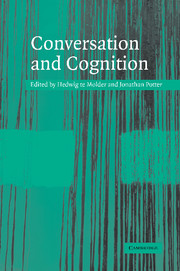Book contents
- Frontmatter
- Contents
- List of contributors
- Acknowledgements
- Transcription conventions
- 1 Talking cognition: mapping and making the terrain
- Part I The interface between cognition and action
- 2 Validating ‘observations’ in discourse studies: a methodological reason for attention to cognition
- 3 Language without mind
- 4 Using participants' video-stimulated comments to complement analyses of interactional practices
- 5 From paradigm to prototype and back again: interactive aspects of ‘cognitive processing’ in standardized survey interviews
- 6 A cognitive agnostic in conversation analysis: when do strategies affect spoken interaction?
- Part II Cognition in action
- References
- Index
4 - Using participants' video-stimulated comments to complement analyses of interactional practices
Published online by Cambridge University Press: 22 September 2009
- Frontmatter
- Contents
- List of contributors
- Acknowledgements
- Transcription conventions
- 1 Talking cognition: mapping and making the terrain
- Part I The interface between cognition and action
- 2 Validating ‘observations’ in discourse studies: a methodological reason for attention to cognition
- 3 Language without mind
- 4 Using participants' video-stimulated comments to complement analyses of interactional practices
- 5 From paradigm to prototype and back again: interactive aspects of ‘cognitive processing’ in standardized survey interviews
- 6 A cognitive agnostic in conversation analysis: when do strategies affect spoken interaction?
- Part II Cognition in action
- References
- Index
Summary
As conversation analysts, we analyze the sense-making practices that participants use to accomplish conversational actions, identities and roles. We study these practices by closely observing the details of the conduct of people in interaction as captured or rendered on videotape and/or audiotape recordings. For a number of reasons, many conversation analysts have been strongly reluctant to turn to the participants of an interaction as informants about aspects of the interaction. The reluctance is based on scepticism about a model of social action in which aspects of cognition are used to explain social action, the methods of eliciting self-reports of subjects' perceptions, the validity of such reports, and the temptation to privilege informants' accounts over, or even substitute them for, investigators' analyses of practices.
Through much of my professional career, the sole data I used for my analyses were audiotapes and videotapes of interaction. In some more recent studies, my collaborators and I used ethnographic data along with tape-recordings of interaction. We collected video stimulated comments as data, obtained by asking each of the participants of the interaction under investigation to view a videotape of the interaction and offer comments while viewing it. I will refer to the initial videotaped interaction as Event and the subsequent interaction in which an Event participant offered comments while viewing the videotape as Event.
The position that I am advocating is the following: the conversation analytic program of research is built on close analysis of interactional data, for example, audio and videotapes of interaction.
- Type
- Chapter
- Information
- Conversation and Cognition , pp. 93 - 113Publisher: Cambridge University PressPrint publication year: 2005
- 62
- Cited by



